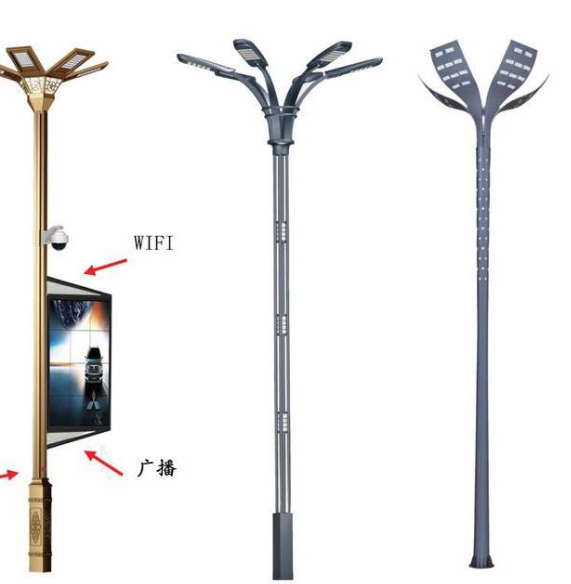The dimming methods of LED multifunctional smart light poles include thyristor (TRIAC) dimming method, analog dimming method and pulse width modulation (PWM) dimming method. The methods are also very convenient and smooth. The maintenance requirements of the LED multifunctional smart light pole include regular inspection of the pole body and the integrity and operation status of the system, and the corresponding inspection of the system platform should be carried out at least once a month, etc.
Dimmi ng method of LED multifunctional smart light pole
ng method of LED multifunctional smart light pole
- Thyristor (TRIAC) dimming method
Wall-mounted thyristor control systems are commonly used for dimming traditional incandescent and halogen lamps. However, in order to popularize LED lamps as soon as possible, some LED drivers are also compatible with (TRIAC) dimming mode, which will cause serious distortion of the voltage waveform after being used, thereby reducing the system power factor. According to foreign designs of TRIAC-compatible LED driver ICs, although the performance has been improved, there will still be low system efficiency and LED light color shifting, which cannot meet the standards and effects of energy saving and emission reduction.
- Analog dimming method
Analog dimming is to achieve the purpose of dimming through the forward current of the LED lamp. The brightness of the LED is almost proportional to the magnitude of the DC current passing through the LED, etc. The current of the LED lamp can be changed by changing the size of the current detection resistor connected in series with the LED lamp; or by connecting the voltage input interface of the LED driver chip and changing the input voltage. But at the same time, it will also change the color temperature and spectrum of LED lights, especially for LED lighting systems that use RGB, which will cause serious color cast problems and cause discomfort to the human eye; adjusting the current of LED lights will also cause a flickering problem. Therefore, the analog dimming method is also not suitable for dimming LED lights.
- Pulse width modulation (PWM) dimming method
LED is a semiconductor light-emitting diode that can be turned on and off quickly, and the speed can reach the microsecond level. Therefore, the LED constant current drive can be between working and non-working. As long as the switching frequency is greater than 100Hz, the human eye will not recognize the flickering of the light, and what we see is the average brightness of the LED light. When PWM dimming is used, since the current is always changing between the fixed value and zero value, there will be no color shift and stepless dimming, which will not affect the efficiency of the entire LED lighting system.
In pulse width modulation, the current through the LED is switched on and off at a very high frequency, usually thousands of times per second. The current passing through the LED is equal to the average value of the current in the LED switching cycle, and the average current or effective current can be reduced by reducing the power-on time of the LED, thereby reducing the brightness of the LED. The generation of PWM waves can be realized by simple programming through a microcontroller, and can be flexibly controlled. The cost is relatively high, but it is a dimming method suitable for LED lights.
Maintenance requirements for LED multifunctional smart light poles
- The operation and maintenance unit of the LED multi-functional smart light pole should formulate the operation and maintenance management system of the LED multi-functional smart light pole, and equip special personnel who have undergone professional training and passed the examination to be responsible for the management, operation and maintenance of the LED multi-functional smart light pole. And truthfully fill in the system operation and maintenance records;
- The integrity and operation status of the rod body and system equipment should be checked regularly; inspection and maintenance work should be done well during the typhoon season every year; the grounding resistance of various grounding devices of the system must be checked and tested before entering the thunderstorm season every year, and should be checked regularly Integrity and effectiveness of lightning protection devices;
- At least one functional inspection of the system platform should be carried out every month, and the operation and maintenance report of the system should be printed and sorted;
- Spare parts are sufficient, and their technical indicators should match the performance of the original system. The use of spare parts shall be truthfully registered;
- Regularly train maintenance personnel, and contact the contractor or manufacturer within 45 hours for complex situations that cannot be handled by maintenance personnel to obtain technical support;
- To add equipment resources or engage in operation and maintenance work on LED multi-functional smart light poles, it is necessary to submit an application to the relevant department, and it can only be implemented after review and approval. Units or individuals are prohibited from erecting communication cables without authorization or arbitrarily connecting, dismantling, relocating, Change equipment.
The above is your answer to “What are the dimming methods and maintenance requirements for LED multifunctional smart light poles?” If you have any doubts, you can contact us at any time.






